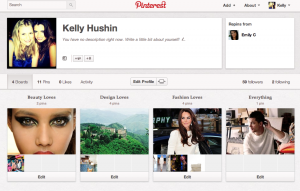At this point if you haven’t heard of Pinterest, you are officially living under the proverbial rock.
I’ll do my best to move on and forgive with a debriefing: Pinterest allows people to share who they are by sharing the things that they like via online pin boards, kind of like the olden-day cork boards. The site has become the third most popular social network, ranking behind only Facebook and Twitter – the THIRD. And it’s been around for like, a day. Ok, maybe more than that, but still – the third?!
In many ways, you could say that exploring Pinterest is an exercise in virtual window-shopping. People create their own collages or browse through other people’s collections to acquire shopping ideas. Pinning an item creates a sense of ownership for the person who pins or re-pins it to a collage. “This Versace dress WILL be mine,” “I WILL inhabit this glorious tropical island,” “My makeup WILL look like this for that wedding I’m at next weekend.”
If all this sounds a bit girly, it’s no accident. Pinterest, by some accounts, is a woman’s game for now. At least that’s what several retail experts have said to me. Fact is, the site is growing exponentially every month, particularly among female users. Perhaps Pinterest will manage to convince the male demographic to start pinning their favorite movies, clothes, etc., but the strategy to target this behavior is still TBD.
The important factor to note about Pinterest is its potential for retail power. Retailers who maintain Pinterest pages may have a much better chance of getting their products in front of new customers as the site doesn’t require users to “like” a brand page or to sign up to follow a Twitter feed. Images from retailers can simply exist in a space where new customers can easily find it.
According to a PriceGrabber survey, 21 percent of respondents said that they have purchased items found on other people’s pinboards. Top retailers like Barneys New York and Aeropostale have “Pin It” buttons on their websites so that people can easily put images of products onto their pinboards.
We all know that people who post to social media are among a brand’s most outspoken promoters as they spend 20 percent more when they perceive that their favorite retailer provides good customer service through venues like Pinterest. These evangelists are also three times as likely to tell others about their positive brand experience. Simply stated, retailers who ignore Pinterest will miss out on a crucial marketing opportunity.
So what does the pinning trend say about social media in general? IMHO (that’s text speak for “in my honest opinion”), it shows the importance consumers place on having a personal, connected experience with the brands they support. Retailers work hard to convince buyers that their brand tells a customer’s personal story. Pinterest is the “small talk” hub of social media. Instead of sharing pithy status updates, family photos or other details, you simply talk to people about the things that you like. Pinterest delves into our need for that quintessential water cooler conversation. By creating a presence on Pinterest, retailers ensure that their products become part of the conversation.
Pinterest’s popularity also shows how visually-minded consumers have become and how they strive to recreate the tangible, tactile experience had when interacting, physically, with products. We have not yet reached an age where digital shopping completely replaces in-store shopping: touching a product is a lot different than seeing it, even if and when there are 14 different ways to view it, a video showcasing it, multiple zoom functions and more.
Retailers need to be cognizant of just how profound an effect it can have when consumers have not only your ecommerce site as a vehicle to interact with your products, but their own personal inspiration boards, where they can imagine themselves owning your products, touching them, wearing them – what have you – and bringing them into the story of their lives.





Recent Comments